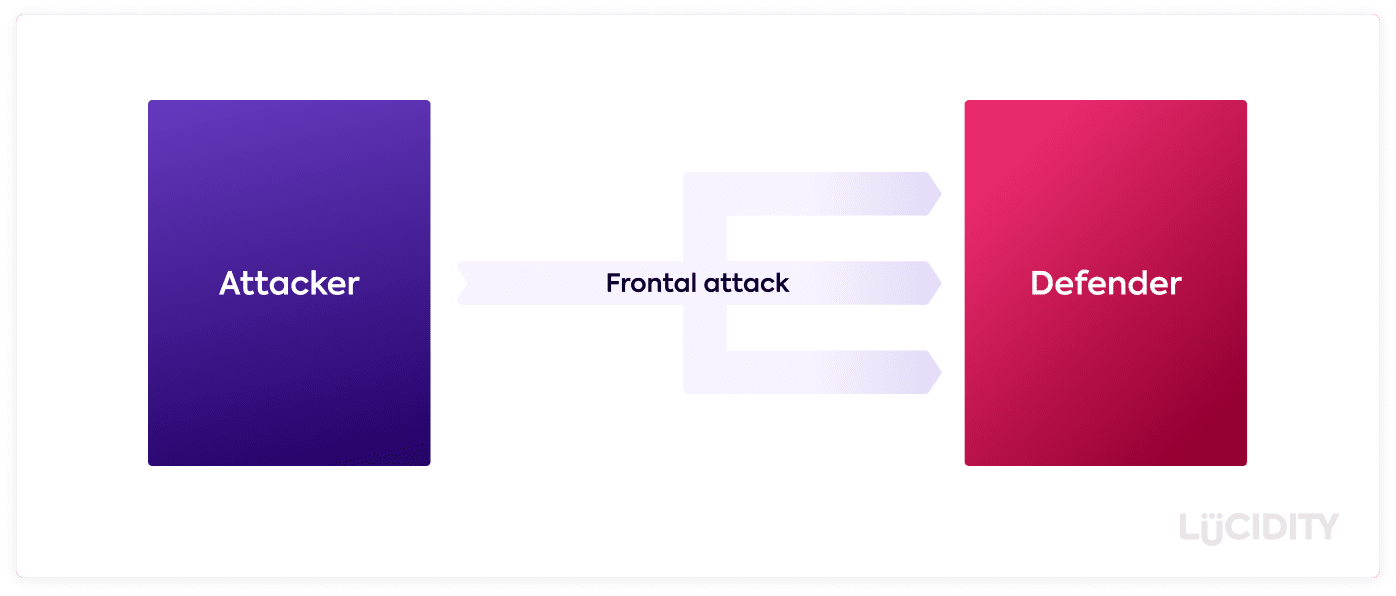There are a number of strategies that are classed as ‘attack strategies’, where the implementor of the strategy is proactively attacking a defender. This is often the case for a new entrant into an established market.
In this guide we’ll examine this Frontal Attack Strategy. It’s a difficult strategy to pull off and not without risk, so read on to learn all you can before you launch in…
What is a Frontal Attack Strategy?
Frontal Attack Strategy is a direct challenge to the market leader or leaders. It’s where you ape the competition’s strengths and match them to provide buyers with a viable alternative.
This approach can be challenging as you are taking on an established company and attempting to beat them at their own game. If done badly, it’ll impact your brand, customers and sales, whilst bolstering the competitor substantially.
What different types of Frontal Attack Strategy are there?
The category of attack strategy has several forms:
Pure Frontal Attack
In a Pure Frontal Attack you are matching the competitors in all aspects of their features, marketing and positioning. So much so that if you were to lay out a SWOT of yourselves and them, the Strengths and Opportunities would be very similar.
Limited Frontal Attack
With a Limited Frontal Attack you are focused on one particular niche or segment of your competitors marketplace. It might be a specific product or customer type, but within that niche you are, again, matching all aspects of their features, marketing and positioning. This is often the easiest Frontal Attack strategy to be successful with, by becoming a specialist in one area of your competitors products or services.
Research & Development Frontal Attack
With an R&D Frontal Attack you are investing in developing a product or service to compete against the company you are attacking, matching their innovation and giving yourself more chance of success longer term – though at a cost of investment.
How do you decide which Frontal Attack Strategy to use?
There’s a commonly held belief that succeeding with a Frontal Attack Strategy requires having considerably more fire power than your compeitior. It is therefore often used by larger businesses that are already established in other markets and have the resources and ‘fire power’ necessary to move into different, say, geographic markets and take on the market leader there with a full force, guns blazing, Frontal Attack. That is, at least, the case for a Pure Frontal Attack.
Picking the particular type of Frontal Attack Strategy to deploy depends on the market you’re entering, the amount you wish to invest, the resources you have and the competitor you are attacking.
For example, if the competitor is a very broad ranging company in a large market, with vast amounts of products or services, then you may decide to go for a Limited Frontal Attack strategy. This would be especially sensible if you think you may lack the fire power to go on the full Pure Frontal Attack. Consider how Instagram, prior to being purchased by Facebook, competed against them. They focused solely on the photo sharing element of Facebook to great success.
What are the advantages of a Frontal Attack Strategy?
The advantages of a Frontal Attack Strategy include:
- If successful it can make you the market leader
- The strengths you are emulating are known market winners
- There is a clear market opportunity
- Certain market leaders may have trouble responding or be slow to move
What are the disadvantages of a Frontal Attack Strategy?
The disadvantages of a Frontal Attack Strategy include:
- It’s very difficult to get right
- The competitor has a natural advantage over you initially
- It can be expensive to maintain
- It can damage your brand if you are forced to retreat
What tools or frameworks help in developing a Frontal Attack Strategy?
One of the most attractive aspects of the Frontal Attack Strategy is that the compeitior you are attacking has already proved out an approach to market success, so they have demonstrated what works in theory. Despite this, in order to get a Frontal Attack Strategy right, you need to prepare by doing some serious competitor and market analysis. You need to ensure you have a deep knowledge and understanding of how your competitor operates and differentiates itself and how the wider market works.
Consider tools such as Five Forces and Four Corner Analysis to look at the behaviour of the wider market, before deciding how to attack. Any market leading competitior has a natural advantage in this strategy to an attacker, so this preparation is invaluable.
At a basic level, you should also complete a SWOT Analysis of your target competitor to help you understand their business. The first box in your SWOT then becomes your to-do list. It’s those strengths you’ve listed out for that business that are what you are targeting. Complete one for your own business and any disparity between your strengths and your competitors will need to be resolved if you’re to succeed at a Frontal Attack Strategy.
What are some examples of a Frontal Attack Strategy?
A well-known example of a Frontal Attack Strategy is that of Coca-Cola vs Pepsi. Despite also dating back to the 1890s, Pepsi arrived on the scene 5 years later than Coke and attacked them directly. Pepsi started to grow in popularity competing on price point, and of course in the years since has grown to become an intense competitive rival. Both have similar products, price points, and compete for the same market. Pepsi, for example, launched Diet Pepsi shortly after Coke launched Diet Coke – matching their competitor’s product to provide consumers with a viable alternative.
What are the alternatives to a Frontal Attack Strategy?
The Frontal Attack Strategy is one of a number of Attack Strategies:
Flanking Attack Strategy
Where a Frontal Attack Strategy targets a competitor’s strengths, a Flanking Attack Strategy goes after their weaknesses. This can be an easier strategy to succeed at as companies are often less likely to tirelessly defend an aspect of their offering that is weaker, under-performing and not driving growth.
Encirclement Attack Strategy
Here a company is attacking its competitor by targeting several points at the same time. With an Encirclement Attack Strategy the challenger targets BOTH the strengths and weaknesses of the competitor, attacking from all sides. This strategy obviously requires more resource and potentially investment on the part of the challenger company.
Bypass Attack Strategy
With a Bypass Attack Strategy, a company attacks the competitor by going round their core product, often creating a direct substitution. Going back to our Pepsi V Coca-Cola example, Pepsi arguably attempted a Bypass Attack when they launched a mineral water product – offering up a complete substitution for a cola drink. You can also implement a Bypass Attack Strategy by targeting a market or market segment in which the competitor is not active – a different geographic market for example.
Guerrilla Attack Strategy
A collection of small, targeted campaigns to chip away at the competition.
Whether you choose to go full Frontal, or opt for one of the alternative attack strategies, we wish you the best of luck in your battle!
Ready to set your battle plan?
Book your personal demo and we'll get you started with your strategy today












